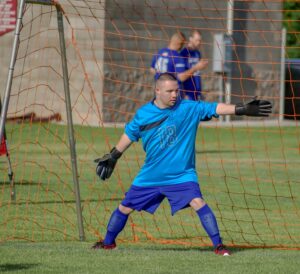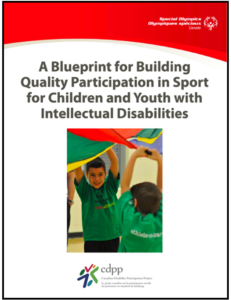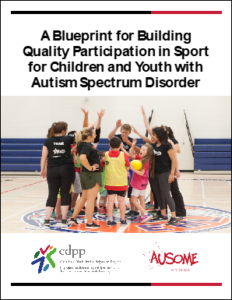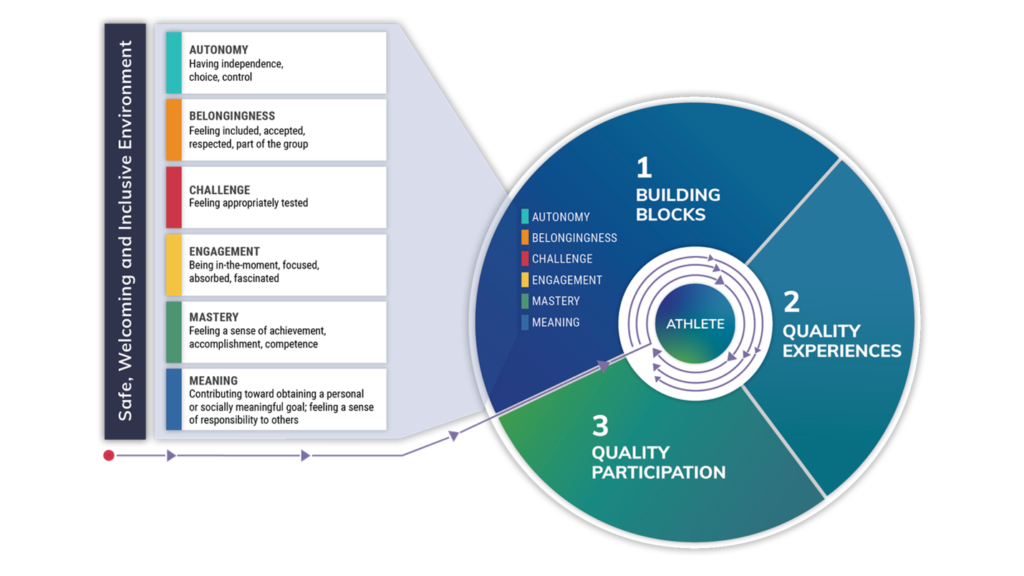Children with intellectual and developmental disabilities (IDD) can benefit physically and psychosocially when they take part in sport (Baran et al., 2009, 2013; Weiss & Bebko, 2008).
Unfortunately, their needs are often neglected, which leads to various physical, social, communication and policy barriers to their involvement (Shields & Synnot, 2016). These obstacles may affect how frequently children wish to be involved in sports and the quality of their participation.
This blog discusses 3 blueprints for how program providers can build sport programs that foster quality participation for children, youth and adults with disabilities. After releasing its first blueprint, the Canadian Disability Participation Project (CDPP) released 2 others in 2020, together with partners Special Olympics Canada and Ausome Ottawa.
Groundwork for quality participation
Quality participation is achieved when athletes with disabilities enjoy participating in sport, and consider their involvement in sports to be satisfying and their experiences to be important (Evans et al., 2018). Quality experiences are built from 6 building blocks: autonomy, belongingness, challenge, engagement, mastery and meaning (Martin Ginis, Evans, Mortenson, & Noreau, 2017).

Consistent exposure of athletes to those building blocks can lead to quality experiences that should contribute to lasting quality participation (Evans et al., 2018). However, the building blocks need a foundation consisting of physical, program and social environments that are safe, welcoming and inclusive (Evans et al., 2018).
As such, the CDPP developed the Quality Participation Framework (described in SIRC’s Is Accessibility Enough? How to Create Quality Experiences in Parasport), which outlined 25 evidence-informed strategies, categorized by environment type, and resources.
Blueprints for quality participation
Recognizing the Framework’s practical implications, the CDPP created A Blueprint for Building Quality Participation in Sport for Children, Youth, and Adults with a Disability. This first user-friendly blueprint presents key concepts that underpin quality participation and provides tools for building quality participation in sport programs for people of all ages with a disability.
Tailoring a blueprint for adults with IDD is a priority area for future partnerships. As the CDPP works toward refining strategies that promote quality participation for adults with IDD, practitioners can rely upon the building blocks to guide their programming. The CDPP research suggests the building blocks apply across age groups, disability groups and performance levels.
 In the meantime, the CDPP’s existing partners identified the need for blueprints specifically for programming for children and youth with IDD. Going beyond the sport context, the CDPP conducted a systematic scoping review to increase its understanding about children (ages 2 to 12 years) with IDD and their quality of participation in leisure, education, and rehabilitation programs (Bruno et al., 2021).
In the meantime, the CDPP’s existing partners identified the need for blueprints specifically for programming for children and youth with IDD. Going beyond the sport context, the CDPP conducted a systematic scoping review to increase its understanding about children (ages 2 to 12 years) with IDD and their quality of participation in leisure, education, and rehabilitation programs (Bruno et al., 2021).
Throughout the review, the CDPP consulted with Special Olympics Canada, the largest national organization dedicated to enriching the lives of Canadians with intellectual disabilities in sport.
The CDPP determined that the building blocks for quality participation also applied to children with IDD. The review identified and synthesized a list of 30 practical strategies underpinning the building blocks and the outcomes associated with quality participation.
Evidence suggested that if program providers combine the strategies, participants may experience various outcomes like empowerment, independence and inclusion. Informed by that review, the CDPP co-developed 2 more blueprints adapted from the original blueprint.
Children and youth with intellectual disabilities
 Program providers don’t always have the knowledge and resources to meet the needs and participation priorities of children with intellectual disabilities. In response, CDPP partnered with Special Olympics Canada to produce a second blueprint: A Blueprint for Building Quality Participation in Sport for Children and Youth with Intellectual Disabilities.
Program providers don’t always have the knowledge and resources to meet the needs and participation priorities of children with intellectual disabilities. In response, CDPP partnered with Special Olympics Canada to produce a second blueprint: A Blueprint for Building Quality Participation in Sport for Children and Youth with Intellectual Disabilities.
This resource is tailored for children and youth, ages 2 to 6 years and 7 to 12 years, in Special Olympics Canada’s Active Start and FUNdamentals recreational programs. This resource identifies 30 strategies for building quality participation in such programs. It can also help to encourage national availability of high-quality, evidence-based sport programming for children with intellectual disabilities.
Key takeaways:
- Belongingness, mastery and challenge rank as the most important building blocks for Special Olympics programming and athletes. At a minimum, these 3 building blocks should be used in this type of programming.
- Targeting the remaining 3 building blocks (autonomy, meaning and engagement) may also be ideal. Strive to go beyond the minimum by adding these other 3 building blocks to enhance program quality.
Children and youth with autism spectrum disorder
It isn’t enough for community sports and recreation programs to allow children and youth on the autism spectrum disorder (ASD) to join, if these programs aren’t built to adequately support their participation.”
Accordingly, Ausome Ottawa, an organization providing sport programming for children and youth with ASD, partnered with CDPP to produce a third blueprint: A Blueprint for Building Quality Participation in Sport for Children and Youth with Autism Spectrum Disorder.
 This blueprint provides coaches, instructors, sports associations, school boards and other groups and individuals with 22 strategies for quality participation. If used, these strategies mean children and youth with ASD would have more access to and inclusivity in sport and recreation programs. By reflecting on their programming, strategy adopters can determine strengths and areas for improvement to ensure children with ASD experience quality participation in sport.
This blueprint provides coaches, instructors, sports associations, school boards and other groups and individuals with 22 strategies for quality participation. If used, these strategies mean children and youth with ASD would have more access to and inclusivity in sport and recreation programs. By reflecting on their programming, strategy adopters can determine strengths and areas for improvement to ensure children with ASD experience quality participation in sport.
Interestingly, exactly the same takeaways apply to children and youth with ASD as to those same age groups with intellectual disabilities.
Conclusion
The CDPP encourages program providers, coaches, sport organizations, and other groups and individuals involved in program delivery to consider quality participation priorities within the context of their programming. The CDPP also recommends they refer to the Quality Participation Strategy Guides within the applicable blueprints.
Key considerations for program providers:
- Understand your program’s and athletes’ unique needs to help you identify which building blocks you should focus on and prioritize.
- Use strategies that align with your program’s priorities and athletes’ needs.
- Implementing a strategy, as described in the blueprints, could influence many building blocks of quality participation.
- It may be impossible or unnecessary to use all the strategies in the blueprints. However, implementing more strategies will likely increase the potential for creating a quality experience for your athletes.
